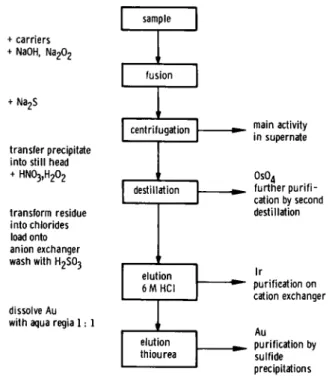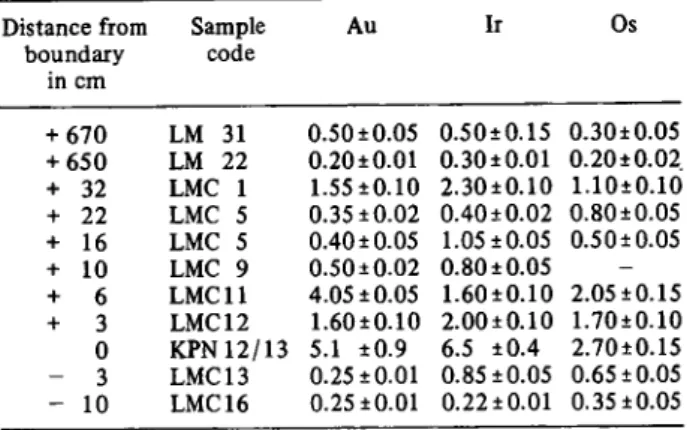Radiochimica Acta 34, 1 3 9 - 1 4 1 (1983) © R. Oldenbourg Verlag, München 1983
Noble Metals in Cretaceous/Tertiary Sediments from El Kef
By M A R T I N A S K U S L Y S and U R S KRÄHENBÜHL, Anorganisch-chemisches Institut, Universität Bern, Freiestrasse 3, CH-3000 Bern 9, Switzerland
(Received June 3, 1983)
Iridium /Trace element anomaly /Extraterrestrial material
Abstract
Sediments from El Kef, Tunisia, were analysed by RNAA for Au, Ir and Os. All three elements show a 1 0 - 20 fold enrichment at the Cretaceous/Tertiary boundary. This enrichment must be the result of the addition of material with a high concentration of noble metals. It is plausible that this exotic material has an extra-terrestrial origin.
Introduction
Siderophil elements (e.g. Ir, Pt, Ni) are normally very much
depleated in the earth crust because of the formation of
the earth core. The enrichment of noble metals in
sedi-ments f r o m the Cretaceous/Tertiary boundary was first
reported by ALVAREZ et al. [ 1 ] a few years ago. These
authors propose, that the pronounced enrichment of Ir
in sediments deposited 65 million years ago must be the
result of the addition of extraterrestrial material with
cosmic composition. Since the publication of these results
many laboratories investigated sediments from various
locations and of variable age for noble metals [2—4]. A
very complete section of sediments containing the
Cretace-ous/Tertiary boundary was found in El Kef, Tunisia. This
material was described by PERCH-NIELSEN [5].
Follow-ing macroscopic studies of the nanofossils, aliquots of
this material were provided for chemical analyses for Os,
Ir and Au.
Experimental
S a m p l e d e s c r i p t i o nThe chemical composition of the analysed sediments changes con-siderably from below to above the Cretaceous/Tertiary boundary [5). The CaC03 content decreases sharply at the boundary f r o m 37 % to about 5% and reaches 0% in 3 samples of the boundary clay. It increases slowly above these samples but does not again reach Cretaceous values in the measured samples. The weight percent distribution of clay minerals is as follows: more than 50% kaolin, 2 5 - 3 0 % montmorillonite and 5 - 1 0 % illite. Neither mineralogy proportions change significantly across the boundary.
P r o c e d u r e
The dried material was sealed in suprasil vials and irradiated to-gether with element standards for two days in the swimming pool reactor SAPHIR.
The irradiated samples were fused in crucibles of zirconium with NaOH and Na, O , in presence of carriers of the interesting
elements. After the decomposition of the melt, sulfides were precipitated and separated by centrifugation. The precipitate was transfered into a still head and acidified by 20 ml conc. H N 03. During the destination H202 was added continuously. 0 s 04 was collected in 6 Μ NaOH. The residue of the destination was trans-formed into the chlorides by multiple addition of conc. HCl and loaded onto an anion exchange column (Dowex 1 X 10, 1 0 0 - 2 0 0 mesh, diameter 1 cm, length 7 cm). The columns were then washed with 5 0 m l of 6 Μ HCl. A reduction with 50ml of O.IJWHJSO., was performed and the Ir was eluted with 50 ml of 6 Μ HCl. Metal-lic Au on the column was dissolved with 10 ml of aqua regia 1 : 1 followed by washing with 20 ml H2 O. Finally, Au was eluted with 50 ml of a 10% solution of thiourea. An outline of the chemical separation is presented in Fig. 1. This is a modification of the procedure of KEAYS et al. [6]. The necessary radiochemical puri-fication for the 3 elements was obtained by the following treat-ment:
- Gold with the shortest half live (2.7 d) was purified first and prepared for activity measurements. The Au solution was made alcaline with NH3. Decomposition of thiourea produced A u2S3, which was dissolved in aqua regia, transformed to chlorides and reprecipitated as Au2 S3. The chemical yield was 65 - 85 %. - Os was further purified by a second 0 s 04 destination and
re-covered as a complex of thiourea. The final precipitate was Os(ΝΗ, CSNH2)6 Cr(SCN)6. The chemical yields were 5 0 to 70%.
- The solution containing Ir was evaporated on a water bath and dissolved in 0.03 Μ HCl. This solution was passed through a cation exchange column (Dowex 50 W X 8, 5 0 - 100 mesh) and Ir was collected in small glass tubes and measured on a well type detector. The chemical yield was determined by atomic absorption ( 5 0 - 6 0 % ) .
+ carriers + NaOH, N a202
+ N a2S
transfer precipitate into still head
+ HN03,H202 transform residue into chlorides load onto anion exchanger wash with H2S 03 dissolve Au with aqua regia 1: 1
140 MARTINAS KUSLYS and URS KRÄHENBÜHL
Results and discussion
The measured concentrations of Ir, Au and Os in the
samples are summarized in Table 1 together with their
distances above and below the Cretaceous/Tertiary
ary. The highest concentrations are observed at the
bound-ary itself. The averages of the values of sample LM 31,
LM 22 and LMC 16 are considered as the natural
back-ground content of these elements in the sediments at El
Kef. At the boundary layer we observed a 16, 19 and 9
fold enrichment for Au, Ir and Os, respectively. This
pro-nounced enrichment can be explained by small additions
of material with extremely high concentrations of these
elements. Material with these properties for the 3
geo-chemically different elements is found in meteorites.
However, at present there is no type of meteorite known
with the observed ratios of the 3 elements. The original
ratio may have been altered by fractionations e.g. by
vola-tilization during the impact or by weathering during the
prolonged contact with water. In addition, the effect of
the observed bioturbation and gardening of a discrete
layer upon the element ratios is not known. Under the
as-sumption of a density of the sediments of 2 g c m "
3, a
thickness of the analysed layers of 1 cm and a linear
gradi-ent of the concgradi-entrations for the trace elemgradi-ents between
measured values, an integral enrichment of 66 ng Ir c m
- 2is calculated. This corresponds to an addition of 125mg
c m
- 2of material with a cosmic composition (e.g. C-l
meteorites [7]). RAMPINO and REYNOLDS [8] as well as
others [e.g. 9, 10] dispute an extraterrestrial origin of the
admixed material to the Cretaceous/Tertiary boundary
clay at El Kef on the basis of the lack of ejecta from the
impact site. They believe together with others [11] that
at least 10 times more target material than projectile
ma-terial should be found at the boundary. But their
detec-tion limit is only about 5% of admixed material with a
dif-ferent composition. It is also difficult to estimate the
a-mount of ejecta which would be produced in case the
impact had occured in the ocean. RAMPINO and
REY-NOLDS prefer vulcanic eruptions as cause for the
anoma-lies. However, with this explanation it is very difficult to
account for the distinct enrichment of the very refractory
noble metals. On the other hand, SMIT and KLAVER [12]
found sanidine spherules in the boundary clay at Caravaca,
Spain, which were undoubtly produced by an impact.
The second, less pronounced enrichment found in our
sample about 25 cm above the C / T boundary is not easy
to explain. GLASS et al. [13] report two layers of
mikro-tektites about 10 cm apart in a North American sediment
which are accompagned by enhanced Ir concentrations.
These authors interpret the double layer as being
pro-duced from a single impact event by subsequent settling
in a high water column (e. g. the ocean) at different
sedi-mentation rates due to different densities of the particles.
If similar processes operated after the Cretaceous/Tertiary
event two horizons could only be detected in an area with
extremely high sedimentation rates. This can be assumed
for El Kef. However, this explanation needs further proof.
Table 1. Au, Ir and Os concentrations (ppb) in sediment samples from El Kef. Errors 1 a. Distance f r o m boundary: + denotes above,
- beneath the boundary. The osmium in sample LMC 9 was lost
Distance from Sample Au Ir Os
boundary code in cm + 670 LM 31 0.50 ±0.05 0.50±0.15 0.30 ±0.05 + 650 LM 22 0.20±0.01 0.30 ±0.01 0.20±0.02 + 32 LMC 1 1.55 ±0.10 2.30±0.10 1.10±0.10 + 22 LMC 5 0.35 ±0.02 0.40 + 0.02 0.80±0.05 + 16 LMC 5 0.40 ±0.05 1.05 ±0.05 0.50±0.05 + 10 LMC 9 0.50 ±0.02 0.80 ±0.05 -+ 6 LMC 11 4.05 ±0.05 1.60±0.10 2.05 ±0.15 + 3 LMC 12 1.60±0.10 2.00 ±0.10 1.70±0.10 0 KPN 1 2 / 1 3 5.1 ±0.9 6.5 ±0.4 2.70±0.15 - 3 LMC 13 0.25 ±0.01 0.85 ±0.05 0.65 ±0.05 - 10 LMC 16 0.25 ±0.01 0.22 ±0.01 0.35 ±0.05
Conclusions
- Sediments at the Cretaceous/Tertiary boundary at El
Kef, Tunisia, show an enrichment of noble metals (Au,
Ir, Os) of u p to a factor 20 compared to average
con-centrations at the same location.
— Two peaks can be distinguished in the concentrations
of Au, Ir, and Os in the investigated sediment section
from Tunisia. This result needs further investigation.
- An extraterrestrial origin of the exotic admixed
materi-al is plausible.
— At this time it is not possible to deduce the
composi-tion of the impacting body since fraccomposi-tionacomposi-tion may
have altered the original concentrations of the measured
elements.
Acknowledgement
We thank K. PERCH-NIELSEN for providing the material.
We are grateful for many stimulating discussions with H. R.
VON GUNTEN. Work supported by Swiss National
Science Foundation.
References
1. ALVAREZ, L. W., ALVAREZ, W., ASARO, F., MICHEL, Η. V.: Extraterrestrial cause for the Cretaceous-Tertiary extinc-tion. Science 208, 1095 (1980).
2. SMIT, J., HERTOGEN, J.: An extraterrestrial event at the Cretaceous-Tertiary boundary. Nature 285, 198 (1980). 3. GANAPATHY, R.: A major meteorite impact on the earth
65 million years ago: Evidence from the Cretaceous-Tertiary boundary clay. Science 209, 921 (1980).
4. KYTE, F. T., ZHOU, Z„ WASSON, J. T.: High noble metal concentrations in a late Pliocene sediment. Nature 292, 417 (1981).
5. PERCH-NIELSEN, K., MCKENZIE, J., HE, Q.: Biostratigraphy and isotope stratigraphy and the 'catastrophic' extinction of calcareous nannoplankton at the Cretaceous/Tertiary bound-ary. Geol. Soc. Am. Special Paper 190, 353 (1982).
Noble Metals in Cretaceous/Tertiary Sediments from El Kef 141
6. KEAYS, R. R., GANAPATHY, R., LAUL, J. C., KRÄHEN-BÜHL, U., MORGAN, J. W.: The simultaneous determination of 20 trace elements in terrestrial, lunar and meteoritic materi-al by radiochemicmateri-al neutron activation anmateri-alysis. Anmateri-al. Chim. Acta 72, 1 (1974).
7. KRÄHENBÜHL, U., MORGAN, J. W., GANAPATHY, R., ANDERS, E.: Abundance of 17 trace elements in carbonaceous chondrites. Geochim. Cosmochim. Acta 37, 1353 (1973). 8. RAMPINO, M. R., REYNOLDS, R. C.: Clay mineralogy of the
Cretaceous-Tertiary boundary clay. Science 219, 495 (1983). 9. WEZEL, F. G , VANNUCCI, S., VANNUCCI, R.: Decouverte de divers niveaux riches en iridium dans la 'Scaglia rossa' et la 'Scaglia bianca' de l'Apennin d'Ombrie-Marches (Italie). C. R. Acad. Sc. Paris 293, 837 (1981).
10. OFFICER, C. B., DRAKE, C. L.: The Cretaceous-Tertiary transition. Science 219, 1383 (1983).
11. RODDY, D. J., BOYCE, J. M., COLTON, G. W., DIAL, A. L.: Meteor crater, Arizona, rim drilling with thickness, structural uplift, diameter, depth, volume, and massbalance calculations. Proc. Lunar Sei. Conf. 6th, 2621 (1975).
12. SMIT, J., KLAVER, G.: Sanidine spherules at the Cretaceous-Tertiary boundary indicate a large impact event. Nature 292, 47 (1981).
13. GLASS, B. P., DUBOIS, D. L„ GANAPATHY, R.: Relation-ship between an Iridium anomaly and the North American mikrotektite layer in core RC-59-58 f r o m the Caribbean Sea. Proc. 13th Lunar Planet. Sei. Conf., J. Geophys. Res. 87, Suppl. A 425 (1982).

